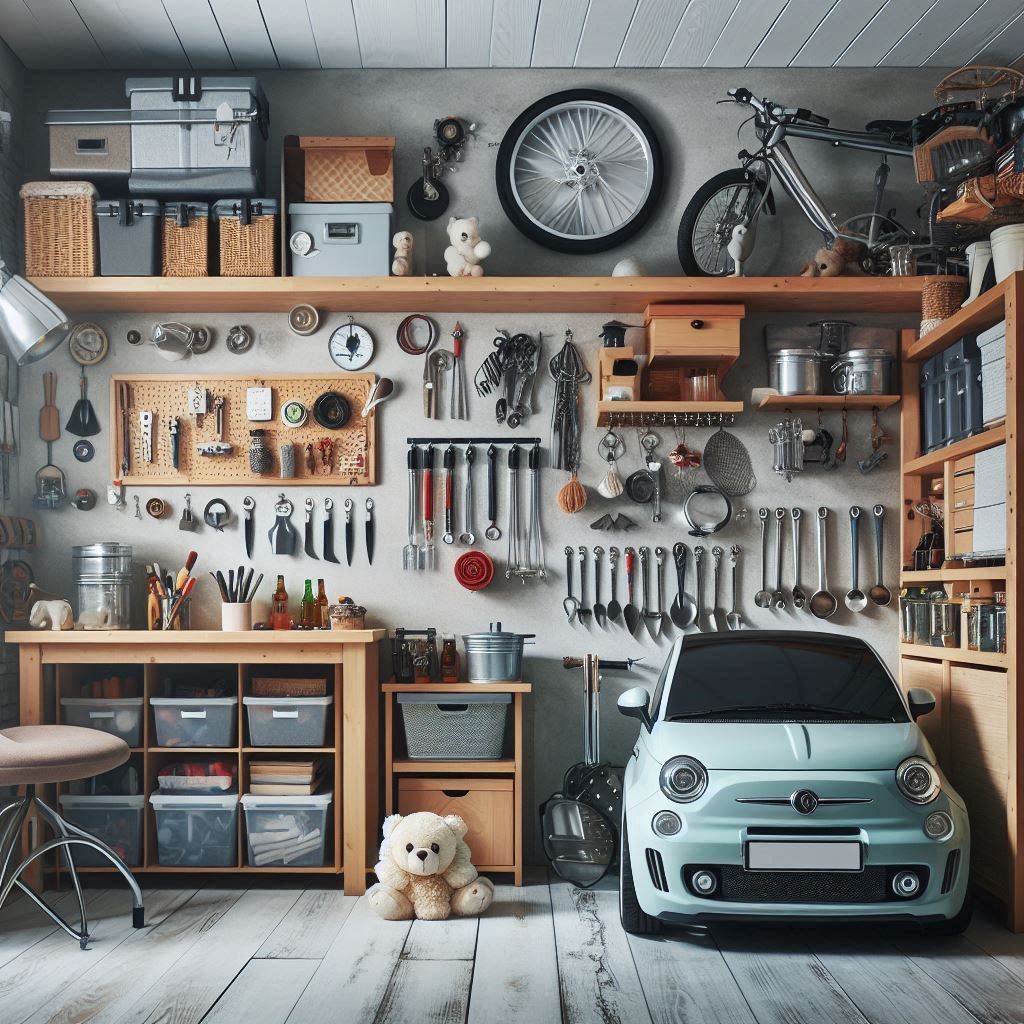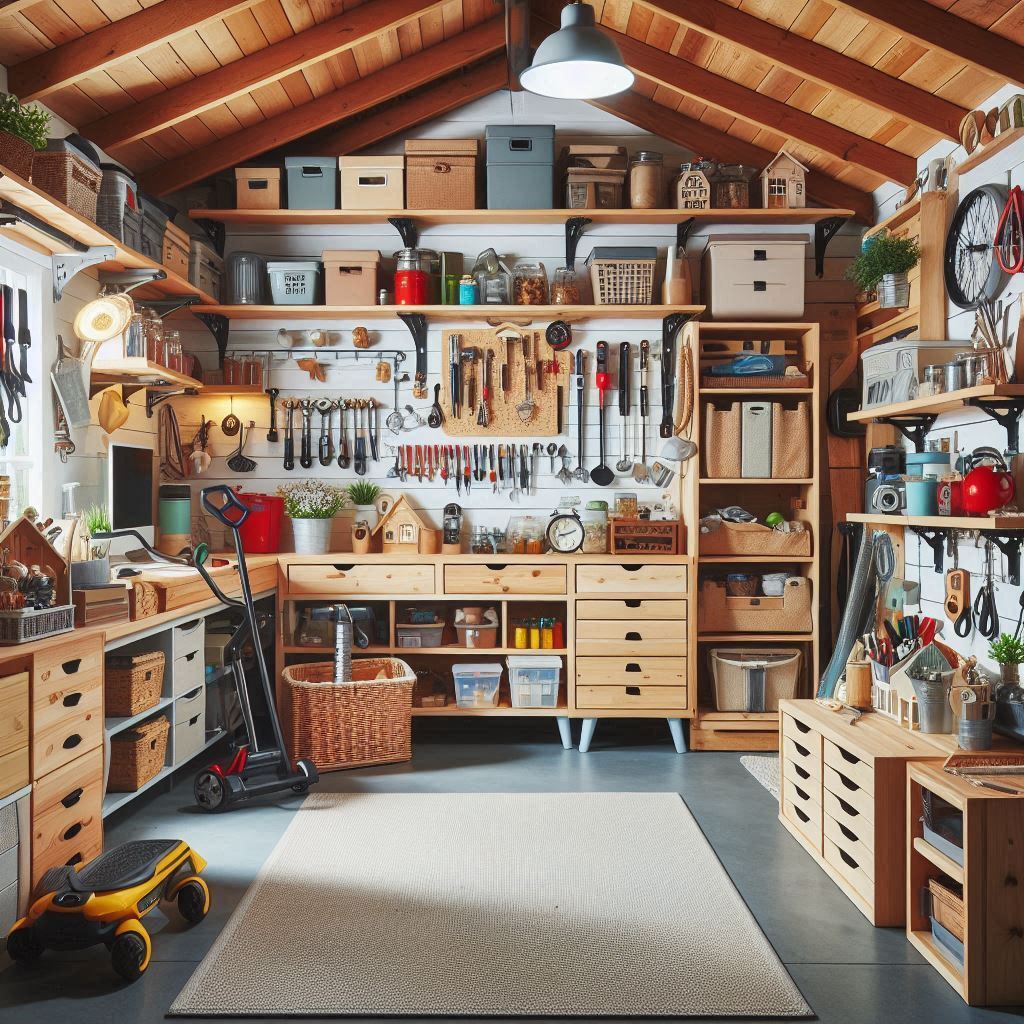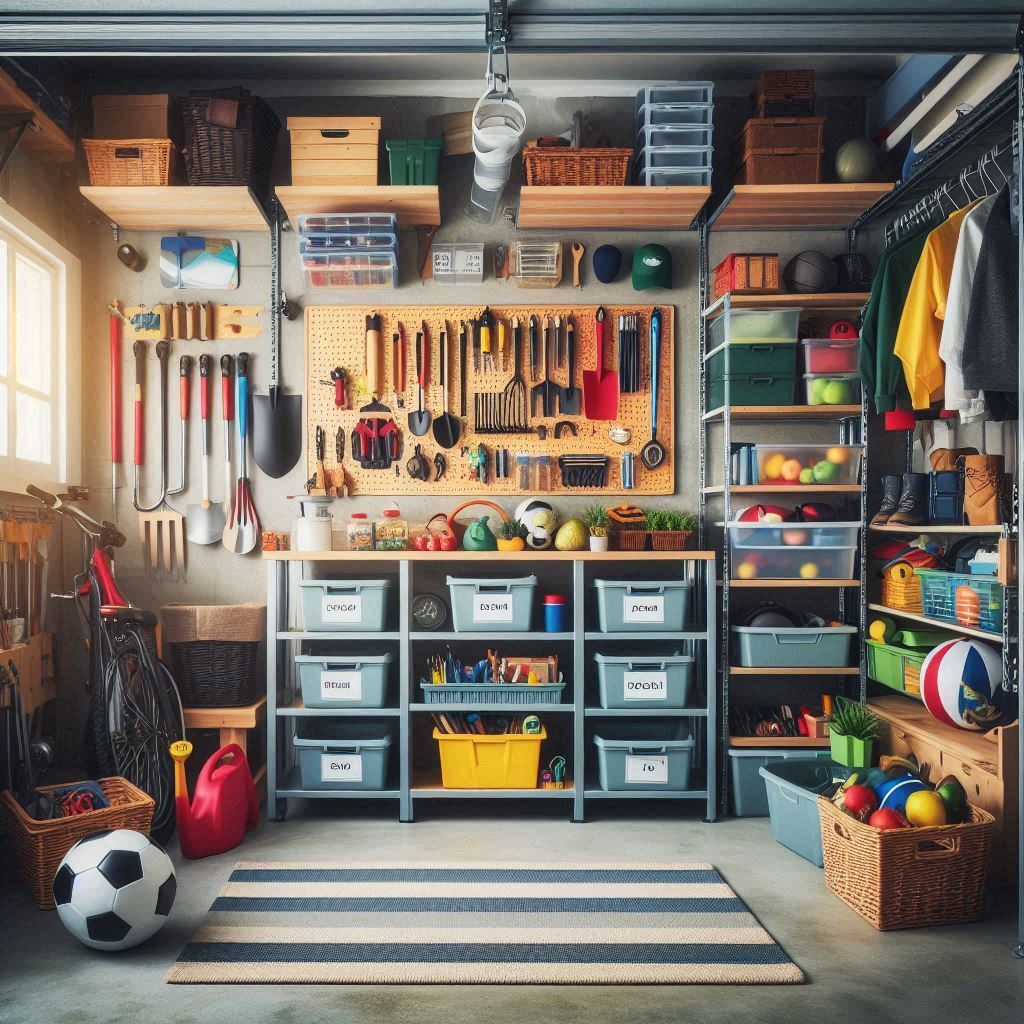
Organizing a small garage can be a challenging task, especially when space is limited and clutter seems inevitable. However, with a well-thought-out plan and the right tools, even the smallest of garages can be transformed into a functional and organized space.
Whether you use your garage for storage, as a workshop, or simply to park your car, maximizing every inch is key. In this article, we’ll explore practical tips and strategies to help you declutter, organize, and make the most of your small garage space.
Small Garage Organization

Decluttering Your Garage
Start with a Clean Slate
Before you can begin organizing, it’s essential to declutter your garage. Remove everything from the space so you can evaluate what you truly need and what can be discarded.
Sort Items into Categories
As you declutter, sort items into categories: keep, donate, sell, and trash. This will help you to quickly identify what needs to stay and what can go.
Dispose of Unnecessary Items
Properly dispose of unwanted items. Recycle materials where possible and consider donating usable items to local charities.
Plan Your Layout
Assess Your Space
Once the garage is empty, assess the available space. Take measurements to determine the best layout for your needs.
Prioritize Functionality
Think about how you want to use your garage. Will it be primarily for storage, a workshop, or both? Prioritize functionality in your layout to ensure it meets your specific needs.
Storage Solutions for Small Garages
Utilize Wall Space
Install Shelving Units
Wall-mounted shelving units are perfect for storing items off the floor and freeing up valuable floor space. Choose adjustable shelves to customize the height as needed.
Use Pegboards
Pegboards are a versatile option for hanging tools, garden equipment, and other items. They can be easily rearranged to accommodate different storage needs.
Overhead Storage
Ceiling-Mounted Racks
Overhead storage racks are ideal for bulky items that are not frequently used, such as seasonal decorations or sporting equipment. Ensure they are securely mounted to support the weight.
Optimize Floor Space
Use Mobile Workbenches
Mobile workbenches can be easily moved when needed, allowing you to maximize floor space while still having a functional workspace.
Keep Items Off the Floor
Whenever possible, keep items off the garage floor to prevent clutter and create a more open, organized space.
Organizing Small Items
Use Clear Bins and Labels
Categorize Small Items
For small items like screws, nails, and other hardware, use clear bins with labels. Categorizing and labeling ensures you can easily find what you need.
Magnetic Strips for Tools
Keep Tools Accessible
Magnetic strips are a great way to keep frequently used tools accessible and organized. Mount them on walls or the inside of cabinet doors for easy access.
Maintaining Your Organized Garage
Establish a Routine
Regular Clean-Up
To keep your garage organized, establish a regular clean-up routine. This will help prevent clutter from building up over time.
Re-Evaluate Your Storage Needs
Adjust as Necessary
As your needs change, re-evaluate your garage organization. Adjust shelving, storage solutions, and layout to accommodate new items or activities.
Final Thoughts
A well-organized garage not only improves functionality but also enhances the overall appearance of your home. By taking the time to declutter, plan your layout, and implement smart storage solutions, you can transform even the smallest garage into a tidy, efficient space.
Regular maintenance and a commitment to staying organized will ensure your garage remains a useful and clutter-free area for years to come.
What Is The Best Option For Small Garage Organization

The best option for organizing a small garage is to maximize vertical and overhead space while keeping the floor as clear as possible. Here are some top strategies:
- Wall-Mounted Shelving: Install adjustable shelves on the walls to store boxes, bins, and tools. This keeps items off the floor and makes them easily accessible.
- Pegboards and Hooks: Use pegboards for hanging tools, garden equipment, and smaller items. Hooks can also be used to hang bicycles, ladders, or other bulky items vertically.
- Overhead Storage Racks: Utilize ceiling-mounted racks for items you don’t need regularly, like seasonal decorations or sports equipment. This frees up valuable wall and floor space.
- Clear Bins with Labels: Store smaller items in clear, labeled bins. This method helps with organization and makes it easy to find things quickly.
- Mobile Workbenches: If you need a workspace in your garage, consider a mobile workbench. It can be moved when necessary to free up space for other tasks.
By combining these strategies, you can efficiently organize a small garage, making it functional and clutter-free.
Garage Storage Ideas For Small Garages

Organizing a small garage can be challenging, but with the right storage solutions, you can maximize space and keep everything tidy. Here are some practical storage ideas for small garages:
Wall-Mounted Storage Solutions
1. Shelving Units
Utilize Wall Space: Install sturdy, wall-mounted shelving units to store boxes, tools, and other items. Adjustable shelves allow you to customize the height based on your needs.
Clear Clutter: By moving items off the floor and onto shelves, you free up valuable space and make the garage feel more organized.
2. Pegboards and Slatwalls
Hang Tools and Accessories: Pegboards and slatwalls are ideal for hanging tools, gardening equipment, and smaller items. They are customizable, allowing you to easily rearrange hooks and baskets as needed.
Versatile Storage: Use hooks, baskets, and shelves on the pegboard to store a variety of items, from wrenches to spray cans.
3. Magnetic Tool Holders
Keep Tools Accessible: Magnetic strips are great for storing metal tools like wrenches, screwdrivers, and pliers. Mount them on the wall to keep your tools visible and within reach.
Overhead Storage Solutions
4. Ceiling-Mounted Racks
Store Bulky Items: Ceiling-mounted storage racks are perfect for items that are not used frequently, such as seasonal decorations or camping gear. This keeps them out of the way but still accessible when needed.
Maximize Vertical Space: Utilizing overhead space is crucial in a small garage, helping to keep the floor clear for other uses.
5. Pulley Systems
Lift and Store: Install a pulley system for bikes, kayaks, or other bulky items. This allows you to lift and store them overhead, freeing up floor space.
Easy Access: Pulley systems make it easy to lower and raise items when you need them, without taking up valuable garage space.
Floor Storage Solutions
6. Mobile Workbenches
Flexible Workspace: Mobile workbenches provide a functional workspace that can be moved around as needed. They often come with built-in storage drawers, helping you keep tools organized.
Space-Saving: When not in use, the workbench can be pushed against a wall or stored in a corner to maximize floor space.
7. Stackable Storage Bins
Organize Small Items: Use stackable storage bins to organize and store smaller items like screws, nails, and other hardware. Clear bins with labels make it easy to find what you need quickly.
Vertical Storage: Stackable bins utilize vertical space, helping to keep the garage floor clear.
8. Foldable Work Tables
Compact and Efficient: Foldable work tables can be set up when needed and easily stored away when not in use. This is perfect for small garages where space is at a premium.
Multi-Purpose: Use the table for various tasks like DIY projects, then fold it up to create more room when done.
Small Garage Organization Tips
9. Declutter Regularly
Keep It Tidy: Regularly go through your garage to remove items you no longer need. This helps prevent clutter from accumulating and makes it easier to maintain an organized space.
10. Label Everything
Easy Identification: Labeling shelves, bins, and boxes ensure you know exactly where everything is. This saves time when searching for items and helps keep the garage organized.
11. Use Corner Shelving
Maximize Every Inch: Corner shelving units are a great way to utilize otherwise unused space. Store smaller items or use them for frequently accessed tools.
12. Install Bike Racks
Vertical Storage: Wall-mounted or ceiling-mounted bike racks are perfect for keeping bikes off the floor. This not only saves space but also protects your bikes from damage.
Low-Profile Garage Cabinets for Small Spaces
In small garages, every inch of space counts. Low-profile garage cabinets are a smart solution for maximizing storage while maintaining a clean and organized environment.
These cabinets are designed to be shallow, making them ideal for tight spaces where traditional cabinets may be too bulky. Below are some ideas and benefits of using low-profile garage cabinets in small spaces.
Benefits of Low-Profile Garage Cabinets
1. Space Efficiency
Slim Design: Low-profile cabinets are typically only 12 to 16 inches deep, compared to standard cabinets that can be up to 24 inches deep. This slim design saves valuable floor space, making it easier to maneuver within the garage.
Wall-Mounted Options: Many low-profile cabinets can be wall-mounted, keeping the floor clear for other uses and providing additional storage at eye level.
2. Organized Storage
Compartmentalized Interiors: Despite their shallow depth, these cabinets often come with adjustable shelves and compartments, allowing you to customize the storage to suit your needs.
Hide Clutter: Low-profile cabinets help keep your garage looking tidy by providing a place to store tools, cleaning supplies, and other items out of sight.
3. Versatility
Fits Small Spaces: These cabinets are ideal for narrow or awkward spaces in the garage, such as along the sides of the garage door or in corners.
Multi-Purpose Use: Low-profile cabinets can be used for a variety of storage needs, from tools and hardware to seasonal decorations and sports equipment.
Choosing the Right Low-Profile Garage Cabinets
1. Material Considerations
Metal Cabinets: Durable and resistant to wear, metal cabinets are a great choice for storing heavy tools or equipment. They often feature lockable doors for added security.
Wood or MDF Cabinets: Wood and MDF (Medium-Density Fiberboard) cabinets offer a more polished appearance and can be painted or stained to match your garage décor. However, they may not be as durable as metal cabinets.
Plastic Cabinets: Lightweight and easy to clean, plastic cabinets are an affordable option for lighter storage needs. They are also resistant to moisture, making them ideal for storing items that may be affected by damp conditions.
2. Features to Look For
Adjustable Shelves: Look for cabinets with adjustable shelves to maximize storage flexibility. This allows you to create space for larger items or increase storage capacity for smaller tools.
Lockable Doors: For added security, especially if you store valuable tools or hazardous materials, choose cabinets with lockable doors.
Ventilated Designs: If you plan to store items that need air circulation, such as paints or chemicals, opt for cabinets with ventilation features to prevent buildup of fumes.
Installation Tips
1. Measure Your Space
Accurate Measurements: Before purchasing, measure the available wall space to ensure the cabinets will fit. Consider the depth, height, and width of the cabinets to avoid any obstructions.
2. Wall-Mounting
Secure Installation: When wall-mounting low-profile cabinets, ensure they are securely attached to wall studs to support the weight of the contents. Use heavy-duty brackets or anchors for additional stability.
3. Combine with Other Storage Solutions
Maximize Efficiency: Pair low-profile cabinets with other storage solutions like pegboards, shelving units, and overhead racks to create a comprehensive storage system in your small garage.
How To Build A Garage On A Budget
Building a garage can be a significant investment, but with careful planning and cost-saving strategies, you can construct a functional and durable garage without breaking the bank. Here’s a step-by-step guide to help you build a garage on a budget.
1. Planning and Design
Determine Your Needs
Size and Purpose: Consider the size of the garage you need and its intended use. A single-car garage is more cost-effective than a two-car garage, and keeping the design simple can also reduce costs.
Basic vs. Custom Design: Opt for a basic, no-frills design. Custom designs, complex roofing structures, or elaborate finishes can significantly increase the cost.
Budgeting
Set a Realistic Budget: Determine how much you’re willing to spend and stick to that budget. Include costs for materials, labor, permits, and any unexpected expenses.
DIY vs. Hiring Professionals: Consider what tasks you can do yourself to save on labor costs. If you’re handy, you can take on tasks like painting, flooring, or even some of the construction work.
2. Cost-Effective Materials
Choose Affordable Building Materials
Basic Framing: Use standard lumber sizes, like 2x4s for framing, which are widely available and cost-effective. Avoid exotic woods or custom-cut materials.
Concrete Slab: Pouring a concrete slab for the foundation can be expensive, but it’s essential for durability. Shop around for the best price on concrete and consider doing the prep work yourself to save on labor costs.
Prefabricated Kits: Look into prefabricated garage kits, which include all the necessary materials and instructions. These kits are often more affordable than building from scratch and can be assembled by a small team.
Roofing and Siding Options
Metal Roofing: Metal roofing is durable, low-maintenance, and often more affordable than traditional shingles. It’s also easier to install, potentially reducing labor costs.
Vinyl Siding: Vinyl siding is an affordable and low-maintenance option for the exterior of your garage. It comes in a variety of colors and can mimic more expensive materials like wood.
Doors and Windows
Basic Garage Doors: Choose a basic, manually operated garage door instead of an automated one to save on initial costs. You can upgrade to an automatic opener later.
Minimal Windows: Limit the number of windows to save on costs, or consider using reclaimed windows to add natural light without the expense.
3. Building Permits and Regulations
Check Local Building Codes
Permit Requirements: Before you start building, check with your local municipality for permit requirements. Building without the proper permits can lead to fines and costly modifications.
Zoning Laws: Ensure your garage complies with zoning laws, including setbacks from property lines and height restrictions.
DIY vs. Contractor
Hiring a Contractor: For tasks that require professional expertise, like electrical work or complex framing, consider hiring a contractor. Get multiple quotes and ask for references to ensure you’re getting quality work at a fair price.
DIY Labor: Take on tasks you’re comfortable with, such as painting, installing insulation, or even framing if you have the skills. This can significantly reduce labor costs.
4. Finishing Touches on a Budget
Interior Finishes
Insulation and Drywall: Insulate the garage to improve energy efficiency and comfort, especially if you plan to use it as a workshop. Use budget-friendly insulation options like fiberglass batts.
Basic Flooring: Consider using a simple concrete stain or sealant for the floor, which is more affordable than epoxy coatings or other finishes.
Electrical and Lighting
Simple Electrical Plan: Keep the electrical plan simple with a few well-placed outlets and basic lighting fixtures. LED shop lights are an affordable and energy-efficient option for garage lighting.
DIY Installations: If you’re comfortable with basic electrical work, you can install outlets and lighting yourself, but always ensure you follow safety guidelines and local codes.
5. Long-Term Savings
Energy Efficiency
Insulated Doors and Windows: While it might cost a bit more upfront, investing in insulated garage doors and energy-efficient windows can save money on heating and cooling over time.
Solar Power: Consider installing solar panels on your garage roof if it’s within your budget. Over time, the energy savings can offset the initial installation cost.
Low-Maintenance Materials
Durable Choices: Choose materials that require little maintenance over time, such as metal roofing and vinyl siding, to avoid future repair costs.
Conclusion
Organizing a small garage may seem daunting, but with the right strategies and tools, you can maximize your space and create a tidy, functional environment.
By utilizing vertical and overhead storage, investing in low-profile cabinets, and keeping a regular decluttering routine, even the smallest garages can be transformed into organized spaces that meet your needs.
The key is to make the most of every inch, keep the floor clear, and continually assess and adjust your storage solutions as your needs evolve.
FAQs on Small Garage Organization
Q1: What are the best storage solutions for a small garage?
A1: The best storage solutions for a small garage include wall-mounted shelving, pegboards, ceiling-mounted racks, and low-profile cabinets. These options help maximize vertical and overhead space, keeping the floor clear and the garage organized.
Q2: How can I keep my small garage organized over time?
A2: To maintain an organized garage, establish a regular decluttering routine, label storage bins and shelves, and periodically reassess your storage needs. Regular clean-ups and adjustments will help prevent clutter from accumulating.
Q3: What should I do with large, infrequently used items in a small garage?
A3: Large, infrequently used items, such as seasonal decorations or sports equipment, are best stored in overhead racks or ceiling-mounted storage systems. This keeps them out of the way but still accessible when needed.
Q4: How can I create a workspace in my small garage without sacrificing storage?
A4: Consider using a mobile workbench or foldable work table that can be easily moved or stored when not in use. This allows you to create a functional workspace while keeping storage options open.
Q5: Are there any affordable ways to organize a small garage?
A5: Yes, you can organize a small garage affordably by using DIY shelving, repurposing household items like clear plastic bins for storage, and installing simple pegboards for tool organization. These cost-effective solutions can help you maximize space without breaking the bank.
